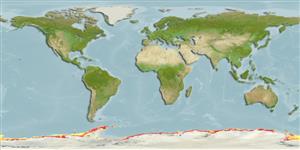>
Perciformes/Notothenioidei (Icefishes) >
Nototheniidae (Cod icefishes) > Trematominae
Etymology: Trematomus: Greek, trematos = hole + Greek, tomo = section, cut (Ref. 45335); bernacchii: Species name bernacchii honors Louis Bernarcchi, an Australian physicist-meteorologist; specimen collected on the Southern Cross Expedition and served on Scott's 1901 expedition (Ref. 45168).
Eponymy: Louis Charles ‘Bunny’ Bernacchi (1876–1942) was a physicist and astronomer who took part in several expeditions to Antarctica. [...] (Ref. 128868), visit book page.
More on author: Boulenger.
Issue
The genus Pseudotrematomus is a synonym of Trematomus, which is confirmed by a molecular study to be published (J.-C. Hureau, pers. comm. 08 Jun. 2010).
Environment: milieu / Klimaatzone / Diepte / distribution range
Ecologie
marien demersaal; diepte 0 - 700 m (Ref. 11892), usually 0 - 200 m (Ref. 45168). Polar; 61°S - 78°S
Southern Ocean: Peter Island, South Shetland, Elephant and South Orkney islands. Mac-Robertson, Queen Mary, Adelie Coasts, Weddell, Davis and Ross seas. East Antarctica from Queen Maud Land to Terre Adelie.
Lengte bij maturiteit / Grootte / Gewicht / Leeftijd
Maturiteit: Lm ?, range 18 - ? cm
Max length : 28.0 cm TL mannelijk / geslacht onbekend; (Ref. 5179); 35.0 cm TL (female); common length : 25.0 cm TL mannelijk / geslacht onbekend; (Ref. 2121); max. gerapporteerde leeftijd: 10 Jaren (Ref. 5179)
Korte beschrijving
Determinatiesleutels | Morfologie | Morfometrie
Dorsale stekels (totaal) : 4 - 6; Dorsale zachte stralen (totaal) : 34 - 39; Anale zachte stralen: 31 - 35. Body brownish, large dark spots in two or three series on body. Spinous dorsal blackish in upper part (Ref. 11892).
Body shape (shape guide): fusiform / normal.
Found in seafloors, well adapted to extremely low and stable temperatures (-1.86°C), annual mean temperature of McMurdo Sound) (Ref. 45168). Feed on polychaetes, gastropods, isopods, amphipods and few algae. Spawn once a year (Ref. 1071). Utilized for human consumption.
Although members of this Family are known to tend to egg masses, it is assumed that because of the high fecundity, this species is a non-guarder (RF), to be corrected if direct information becomes available.
Dewitt, H.H., P.C. Heemstra and O. Gon, 1990. Nototheniidae. p. 279-331. In O. Gon and P.C. Heemstra (eds.) Fishes of the Southern Ocean. J.L.B. Smith Institute of Ichthyology, Grahamstown, South Africa. (Ref. 5179)
Status op de Rode Lijst van het IUCN (Ref. 130435: Version 2025-1)
Gevaar voor de mens
Harmless
Gebruik door de mens
Visserij: commercieel
Tools
Speciale rapporten
Download XML
Internetbronnen
Estimates based on models
Preferred temperature (Ref.
123201): -1.8 - -0.8, mean -1.7 °C (based on 2076 cells).
Fylogenetische diversiteitsindex (Ref.
82804): PD
50 = 0.5001 [Uniqueness, from 0.5 = low to 2.0 = high].
Bayesian length-weight: a=0.00537 (0.00279 - 0.01033), b=3.24 (3.08 - 3.40), in cm total length, based on LWR estimates for this Genus-body shape (Ref.
93245).
Trofisch niveau (Ref.
69278): 3.4 ±0.1 se; based on diet studies.
Generation time: 5.9 (2.0 - 12.2) years. Estimated as median ln(3)/K based on 11
growth studies.
Weerstandsvermogen (Ref.
120179): Gemiddeld, minimale populatieverdubbelingstijd 1,4-4,4 jaar (K=0.19-0.91; tm=3-6; tmax=10; Fec=1,200-3,123).
Fishing Vulnerability (Ref.
59153): Moderate to high vulnerability (53 of 100).
🛈
Nutrients (Ref.
124155): Calcium = 31.4 [18.6, 70.0] mg/100g; Iron = 0.456 [0.206, 0.860] mg/100g; Protein = 17.3 [16.3, 18.4] %; Omega3 = 0.417 [0.228, 0.727] g/100g; Selenium = 15.4 [6.7, 32.6] μg/100g; VitaminA = 15.6 [3.5, 70.7] μg/100g; Zinc = 0.515 [0.356, 0.761] mg/100g (wet weight); based on
nutrient studies.
